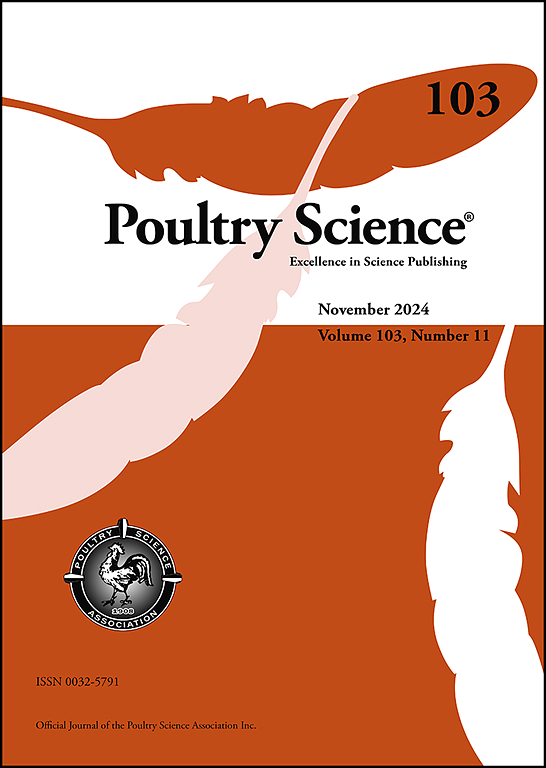Identification of key genes associated with residual feed intake in small-sized meat ducks through integrated analysis of mRNA and miRNA transcriptomes
IF 3.8
1区 农林科学
Q1 AGRICULTURE, DAIRY & ANIMAL SCIENCE
引用次数: 0
Abstract
As a major producer and consumer of duck meat, China faces industry challenges due to low feed conversion efficiency. Residual feed intake (RFI), a key metric for poultry feed utilization, remains poorly characterized in small-sized meat ducks. We raised 1,000 ducklings with similar initial body weight (BW) under controlled conditions until 63 days of age. RFI was calculated using average daily gain (ADG), average daily feed intake (ADFI), and metabolic body weight (MBW0.75). Thirty high-RFI (HRFI) and thirty low-RFI (LRFI) ducks were selected to evaluate growth performance. Hypothalamic samples from 6 HRFI and 6 LRFI ducks underwent transcriptomic analysis, including differential gene expression, gene ontology, Kyoto Encyclopedia of Genes and Genomes pathway analysis, weighted gene co-expression network analysis, and miRNA target prediction. Results showed that the LRFI group had significantly lower feed intake (FI) and ADFI than the HRFI group (P < 0.05). Compared to low RFI controls, HRFI meat ducks exhibited 45 differentially expressed (DE) miRNAs (6 upregulated and 39 downregulated) and 323 DE mRNAs (133 upregulated and 190 downregulated), enriched in substance and energy metabolism pathways. Weighted gene co-expression network analysis identified ten hub DE miRNAs, including miR-1-3p, miR-10-5p/3p, miR-182-5p/3p, miR-183-5p, miR-263-5p, miR-96-5p, miR-7, and novel-m0108-5p. miRNA–mRNA network analysis revealed 43 DE regulatory pairs, including 15 with negative feedback. Notably, miR-182 targeted and regulated the highest number of DE mRNAs, showing negative feedback interactions with DDC, UPP2, PRSS35, and SLCO1C1. Dual-luciferase reporter assays confirmed the binding of partial genes. Given DDC’s role in dopamine and serotonin synthesis, we further validated the miR-182-5p/DDC regulatory relationship through overexpression, interference, and Western blot experiments. This study provides novel insights into the molecular mechanisms underlying feed efficiency in ducks.
求助全文
约1分钟内获得全文
求助全文
来源期刊

Poultry Science
农林科学-奶制品与动物科学
CiteScore
7.60
自引率
15.90%
发文量
0
审稿时长
94 days
期刊介绍:
First self-published in 1921, Poultry Science is an internationally renowned monthly journal, known as the authoritative source for a broad range of poultry information and high-caliber research. The journal plays a pivotal role in the dissemination of preeminent poultry-related knowledge across all disciplines. As of January 2020, Poultry Science will become an Open Access journal with no subscription charges, meaning authors who publish here can make their research immediately, permanently, and freely accessible worldwide while retaining copyright to their work. Papers submitted for publication after October 1, 2019 will be published as Open Access papers.
An international journal, Poultry Science publishes original papers, research notes, symposium papers, and reviews of basic science as applied to poultry. This authoritative source of poultry information is consistently ranked by ISI Impact Factor as one of the top 10 agriculture, dairy and animal science journals to deliver high-caliber research. Currently it is the highest-ranked (by Impact Factor and Eigenfactor) journal dedicated to publishing poultry research. Subject areas include breeding, genetics, education, production, management, environment, health, behavior, welfare, immunology, molecular biology, metabolism, nutrition, physiology, reproduction, processing, and products.
 求助内容:
求助内容: 应助结果提醒方式:
应助结果提醒方式:


